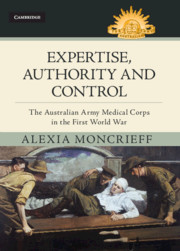Book contents
- Expertise, Authority and Control
- Other titles in the Australian Army History Series
- Expertise, Authority and Control
- Copyright page
- Contents
- Figures, maps and tables
- Preface
- Acknowledgements
- Note on style
- Abbreviations
- Introduction
- Chapter 1 Gallipoli
- Chapter 2 Medicine in the lines
- Chapter 3 The Western Front in 1918
- Chapter 4 A pleasant dose of medicine?
- Chapter 5 The most difficult problem
- Conclusion
- Notes
- Bibliography
- Index
Conclusion
Developing an Australian medical service
Published online by Cambridge University Press: 10 February 2020
- Expertise, Authority and Control
- Other titles in the Australian Army History Series
- Expertise, Authority and Control
- Copyright page
- Contents
- Figures, maps and tables
- Preface
- Acknowledgements
- Note on style
- Abbreviations
- Introduction
- Chapter 1 Gallipoli
- Chapter 2 Medicine in the lines
- Chapter 3 The Western Front in 1918
- Chapter 4 A pleasant dose of medicine?
- Chapter 5 The most difficult problem
- Conclusion
- Notes
- Bibliography
- Index
Summary
At the end of 1918, the Australian Army Medical Corps (AAMC) was a different organisation from the one that had existed when war was declared in 1914. Commencing the war with a regular staff of four officers, the AAMC rapidly expanded and developed. Almost entirely dependent on assistance from Britain and the Royal Army Medical Corps (RAMC) during the Gallipoli campaign in 1915, the AAMC, during the remaining years of the war, became more independent, developed its own practices and procedures, and asserted its expertise in order to have Australian medical control of Australian casualties.
- Type
- Chapter
- Information
- Expertise, Authority and ControlThe Australian Army Medical Corps in the First World War, pp. 179 - 187Publisher: Cambridge University PressPrint publication year: 2020

